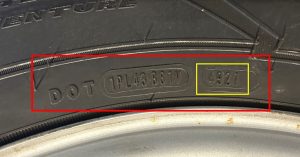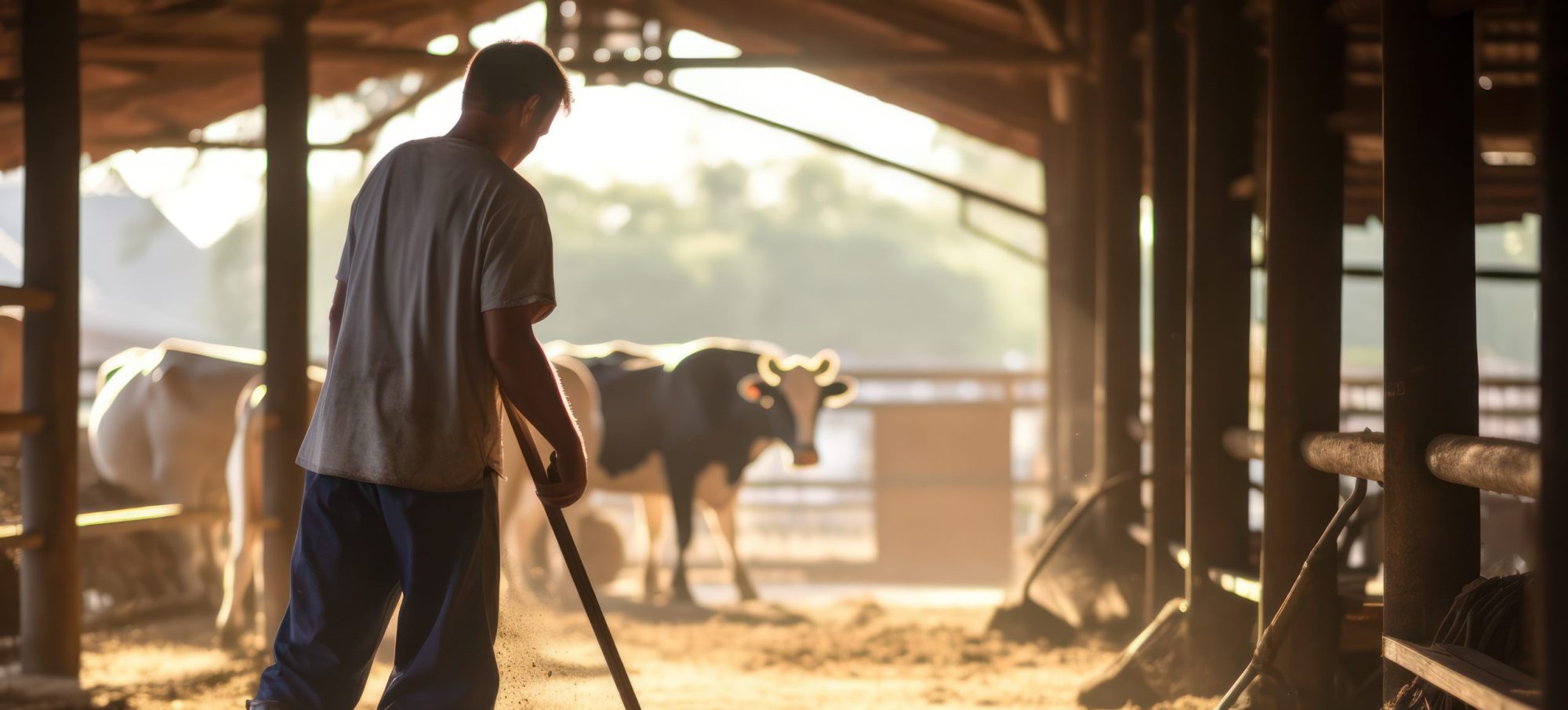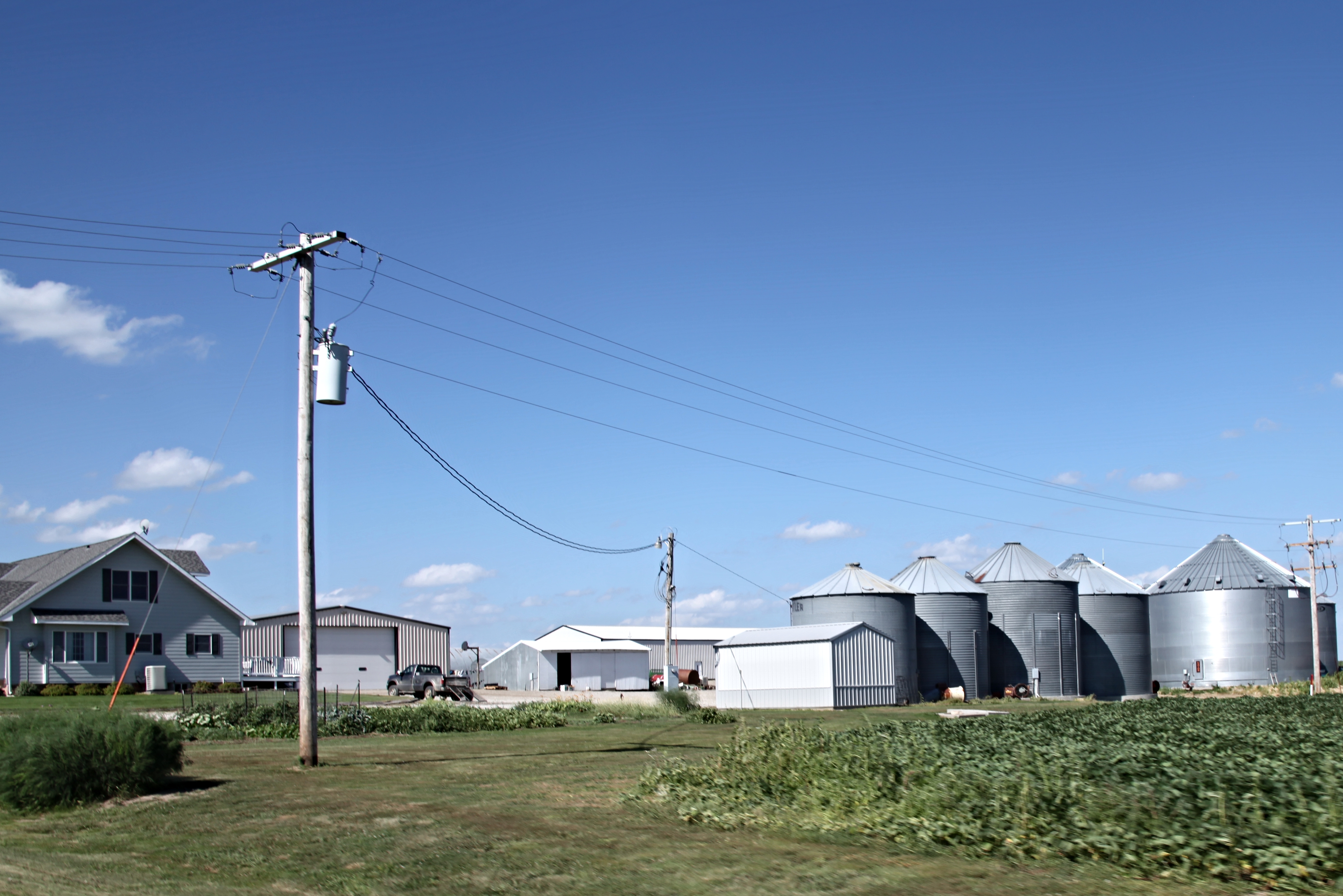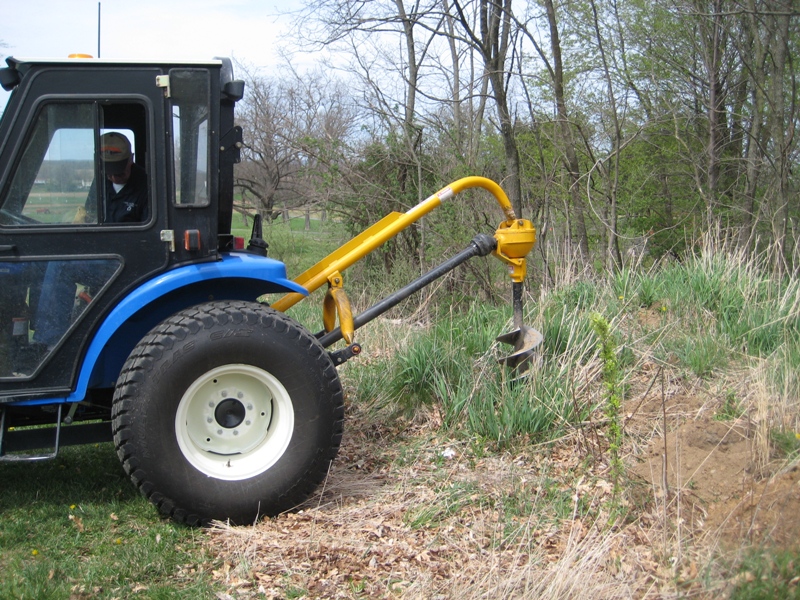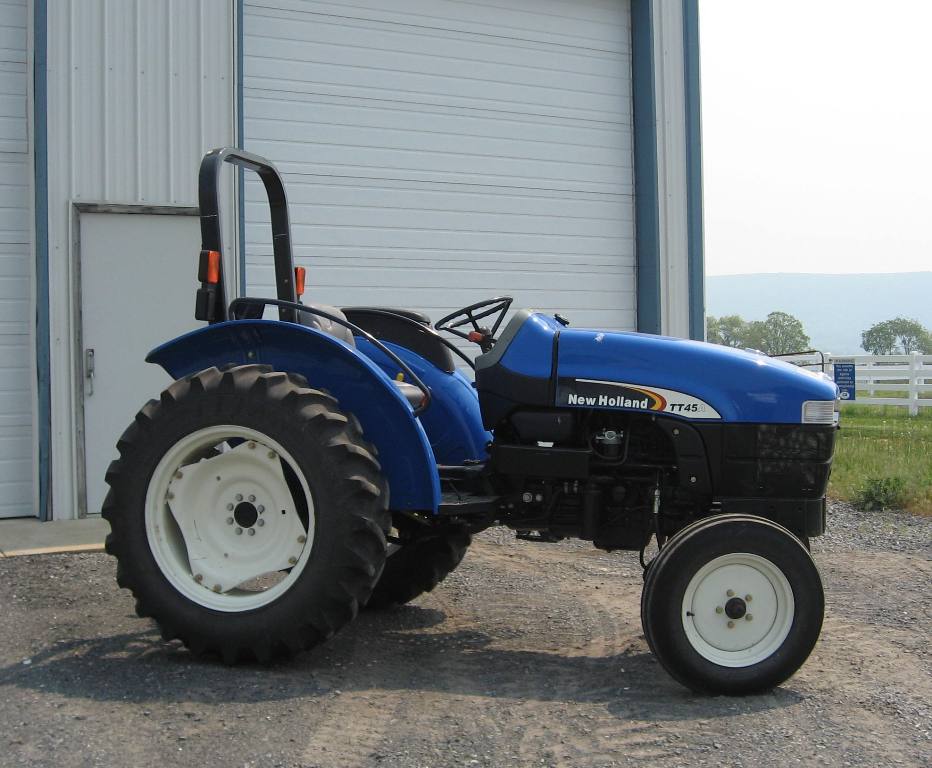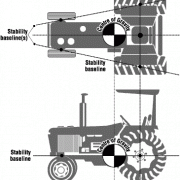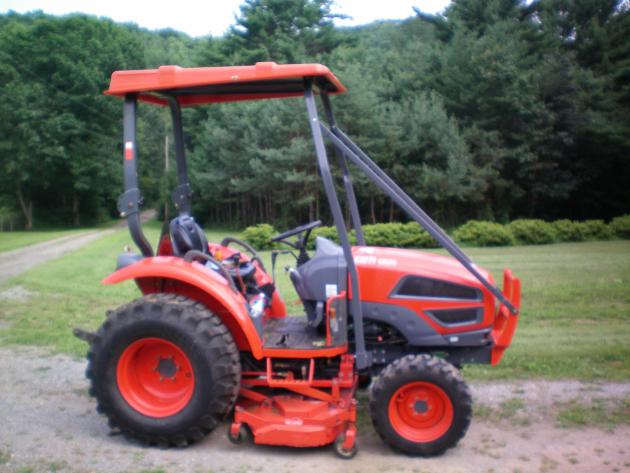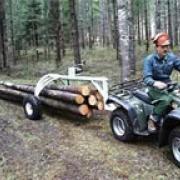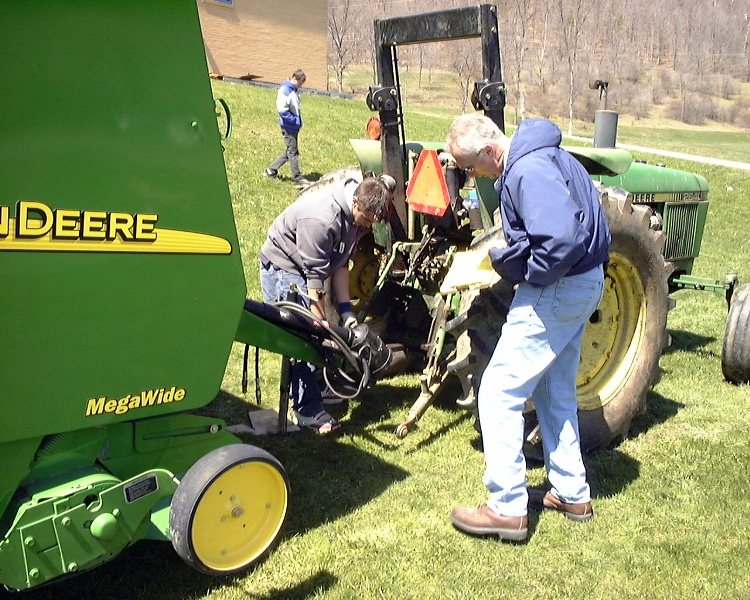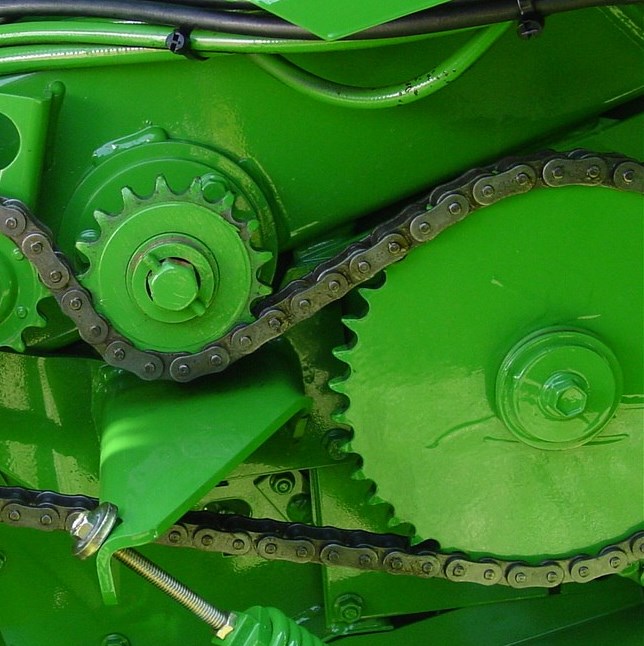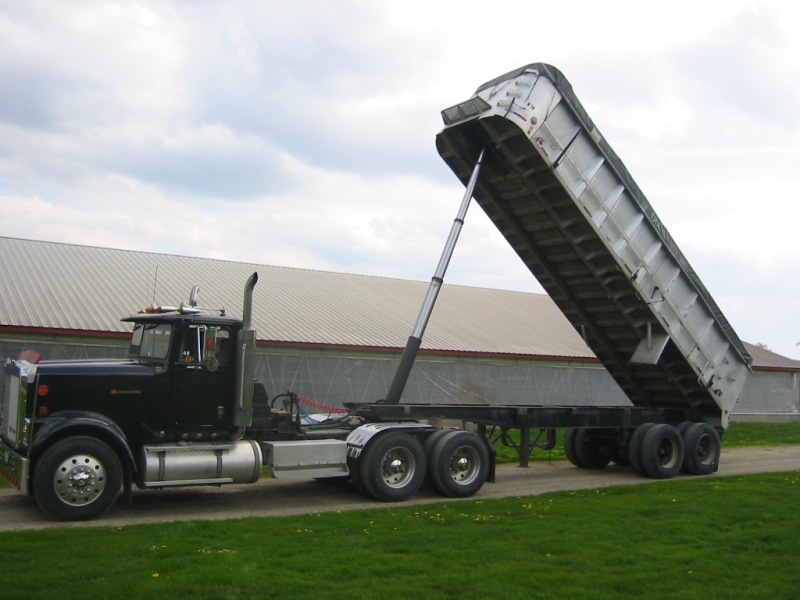
(Source: Penn State Agricultural Safety & Health)
Use the following format to cite this article:
Dump truck and trailer safety. (2014) Farm and Ranch eXtension in Safety and Health (FReSH) Community of Practice. Retrieved from http://articles.extension.org/pages/70373/dump-truck-and-trailer-safety.
Farmers and ranchers use dump trucks and trailers to transport large amounts of grain and silage between farms or to market, making it cost-effective for many agricultural operations. In addition to large trucks and trailers, farmers and ranchers use semitrailer end dump trucks, pup trailers, truck and grain trailers, and regular or long-bed straight trucks. All trucks or trailers with dumping capability use a hydraulic hoist to dump their loads (grain, sand, gravel, and so on).
Most Common Incidents
The most common dump truck or trailer incidents occur when emptying a load, when a bed is lowered unexpectedly, or when a raised bed contacts overhead power lines.
Emptying a Load
Anytime the bed of the truck or trailer is raised, it places workers at risk unless hazardous situations are controlled or eliminated. Operators need to understand that a dump truck or trailer is at a risk for a tipping incident when the bed is raised because raising the bed changes the truck’s center of gravity. Even if a dumping area is relatively flat, a tipping incident could occur if a slope is created by low tire pressure on one side or one set of tires sitting in a low area or a depression. Additional hazards that can increase the risk of a tipping incident include wind, loads that are not centered, and jack-knifed trailers. The longer the trailer, the more surface area is exposed to high winds, placing lateral pressure on the trailer and creating the potential for a tipping incident.
When filling the truck or dump trailer, evenly distribute the contents to maintain proper flow and prevent the load from shifting during unloading. When emptying, raise the bed slowly and allow the contents to slide slowly toward the rear. If the bed is raised too quickly, the rearward shift of the load could damage the lift mechanism or cause the trailer and truck to tip over. It is important not to jack-knife a truck and trailer, because doing so creates the potential for the cab to be crushed should the trailer tip.
Lowering a Bed Unexpectedly
Workers place themselves in potentially fatal situations when they move between a raised dump bed and the frame of the truck or trailer to complete maintenance or repairs or to check a problem. In this position, a worker could be fatally crushed should the bed lower unexpectedly. An operator could inadvertently lower the bed, the bed’s lift components could fail, or the hoist cylinder could collapse. To reduce the risk of an unexpected bed lowering, truck and trailer beds should be outfitted with a dump box lock bar (shown below) that mechanically blocks the bed from coming down.

(Source: Pennsylvania State University, Agricultural Safety and Health)
Contacting Overhead Wires
The main potential for an electrocution incident occurs when there is contact between a raised dump bed and power lines. Contact typically occurs when a truck pulls away while the dump bed is still raised. Examples of why a driver would not put the dump down include the his or her forgetting or being impatient and pulling away before the dump bed is completely down, catching the dump bed on a power line. In this scenario, the driver, if he or she remains in the truck, is normally protected from electrocution because of the insulation provided by the truck tires. Electrocution could occur if the driver were to leave the cab and be in simultaneous contact with the ground and the cab, completing an electrical circuit—as when, for example, a farmer exits the cab and steps onto the ground with his or her right foot while the left foot is still on a truck step.
If there is an emergency (for example, the truck is on fire from a downed power line) and it is necessary to exit the truck while it is in contact with power lines, jump from the truck and land with your feet together and so that your body is not in contact with both the vehicle and the ground at the same time. Then “bunny hop” away from the truck with your feet together to minimize the voltage difference traveling between your feet.
Additional Hazards Associated with Dump Trucks and Trailers
Slips, falls, and crushing incidents can occur when working around a dump truck or trailer. Workers should make sure that steps are clean of mud and debris and should use stairs and handrails when accessing the truck and trailer. Crushing injuries to fingers and hands may result from opening and closing latches on tailgates or tailgate hinges. More severe crushing injuries can occur when a worker is between the dump truck or trailer and a building or other structure.
Another potential hazard is a shear-line hazard, which occurs when a large vehicle (a dump truck, combine, or something similar) operates near a ditch bank. Large vehicles can place considerable pressure on the banks of ditches and the shoulders of lanes alongside fields. If the soil on the shoulder is weak from freezing and thawing or prolonged wet weather, the weight of a dump truck or combine could result in soil collapse and a potential tipping incident. To prevent a shear-line collapse, keep your truck or combine as far back from the edge of the ditch or drop-off as the ditch or drop-off is deep.
Loading and Unloading Recommendations
Know the recommended limits of your dump truck and do not overload it. When loading your dump truck or trailer, distribute the load evenly throughout the dump bed. If you are loading a material that has poor flow, load less material than usual and distribute slightly more material to the rear of the bed. Covering the load with a tarpaulin will reduce loss during highway travel and can make unloading of grain easier. For a dumping site, choose a level surface made of concrete or compacted soil or gravel and free from overhead power lines. Prior to raising the dump bed, ensure that the tailgate is unlocked. To avoid an electrocution incident, always wait until the dump bed is completely lowered before moving the dump truck or trailer.
Maintenance
Before you complete any maintenance, always block the truck or trailer dump bed with an approved device such as dump-box lock bars. The following items of routine scheduled maintenance should not be neglected:
- Daily tire pressure checks
- Checks of the lights, horn, brakes, and fluid levels
- Inspection and repair of the suspension systems
- Lubrication of pins and bushings
- Removal of heavy dust from hydraulic lines
- Inspection and repair of hydraulic lift cylinders
Operator Training
Drivers of dump trucks and trailers should be trained in the following:
- Regular maintenance and inspection of the dump truck and trailer
- Recognition of hazardous conditions related to load distribution, unloading surfaces, fire hazard from heavy dust on hydraulic lines, and so on
- Hand signals and safe procedures for a two-person unloading operation
Design Features
The following design features should be considered to reduce the risk of a potential incident:
- When possible, use a bottom dump trailer to reduce the risk of raised bed hazards.
- Install a bed liner in the dump bed to improve the flow of material when dumping.
- Ensure that the trailer is equipped with slope-detector monitoring equipment to limit the height that the load can be lifted on uneven terrain.
- To reduce the risk of slip-and-fall incidents, the trailer should have view windows in the sidewalls to allow workers to monitor the load.
- To improve accessibility, use a fold-down ladder.
- If possible, use sealed ball bearings for tailgates, which make tailgates easier to operate.
- Choose an electric tailgate opener rather than a roller or sliding-door tailgate.
- Choose air suspension seats rather than spring suspension seats.
- Equip dump trucks with backup alarms.
Use the following format to cite this article:
Dump truck and trailer safety. (2014) Farm and Ranch eXtension in Safety and Health (FReSH) Community of Practice. Retrieved from http://articles.extension.org/pages/70373/dump-truck-and-trailer-safety.
Sources
Dump truck safety. (2005) University of California. Agriculture and Natural Resources. Retrieved from http://safety.ucanr.org/files/1343.pdf.
Murphy, D. & Harshman, W. (2005) Farm dump truck and trailer safety. Penn State College of Agricultural Sciences. Retrieved from https://extension.psu.edu/farm-dump-truck-and-trailer-safety.
Reviewed and Summarized by:
Linda M. Fetzer, Pennsylvania State University – lmf8@psu.ed
William C. Harshman, Pennsylvania State University (Has since retired)
Dennis J. Murphy, Pennsylvania State University (Has since retired)
